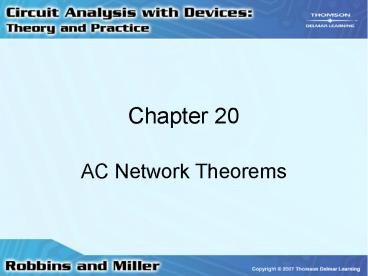AC Network Theorems PowerPoint PPT Presentation
Title: AC Network Theorems
1
Chapter 20
- AC Network Theorems
2
Superposition Theorem
- Voltage across (or current through) an element
- Determined by summing voltage (or current) due to
each independent source - All sources (except dependent sources) other than
the one being considered are eliminated
3
Superposition Theorem
- Replace current sources with opens
- Replace voltage sources with shorts
4
Superposition Theorem
- Circuit may operate at more than one frequency at
a time - Superposition is the only analysis method that
can be used in this case - Reactances must be recalculated for each
different frequency
5
Superposition Theorem
- Diode and transistor circuits will have both dc
and ac sources - Superposition can still be applied
6
Superposition Theorem
- Superposition theorem can be applied only to
voltage and current - It cannot be used to solve for total power
dissipated by an element - Power is not a linear quantity
- Follows a square-law relationship
7
Superposition for Dependent Sources
- If controlling element is external to the circuit
under consideration - Method is the same as for independent sources
8
Superposition for Dependent Sources
- Simply remove sources one at a time and solve for
desired voltage or current - Combine the results
9
Superposition for Dependent Sources
- If the dependent source is controlled by an
element located in the circuit - Analysis is different
- Dependent source cannot be eliminated
10
Superposition for Dependent Sources
- Circuit must be analyzed by considering all
effects simultaneously
11
Thévenins Theorem
- Converts an ac circuit into a single ac voltage
source in series with an equivalent impedance - First, identify and remove the element or
elements across which the equivalent circuit is
to be found
12
Thévenins Theorem
- Label two open terminals
- Set all sources to zero
- Replace voltage sources with shorts
- Current sources with opens
13
Thévenins Theorem
- Calculate the Thévenin equivalent impedance
- Replace the sources and determine open-circuit
voltage
14
Thévenins Theorem
- If more than one source is involved
- Superposition may be used
- Draw resulting Thévenin equivalent circuit
- Including the portion removed
15
Nortons Theorem
- Converts an ac network into an equivalent circuit
- Consists of a single current source and a
parallel impedance - First, identify and remove the element or
elements across which the Norton circuit is to be
found
16
Nortons Theorem
- Label the open terminals
- Set all sources to zero
17
Nortons Theorem
- Determine Norton equivalent impedance
- Replace sources and calculate short-circuit
current
18
Nortons Theorem
- Superposition may be used for multiple sources
- Draw resulting Norton circuit
- Including portion removed
19
Thévenin and Norton Circuits
- Possible to find Norton equivalent circuit from
Thévenin equivalent circuit - Use source transformation method
- ZN ZTh
- IN ETh/ZTh
20
Thévenins and Nortons Theorems
- If a circuit contains a dependent source
controlled by an element outside the area of
interest - Previous methods can be used to find the Thévenin
or Norton circuit
21
Thévenins and Nortons Theorems
- If a circuit contains a dependent source
controlled by an element in the circuit - Other methods must be used
22
Thevenins and Nortons Theorems
- If a circuit has a dependent source controlled by
an element in the circuit - Use following steps to determine equivalent
circuit
23
Thevenins and Nortons Theorems
- First
- Identify and remove branch across equivalent
circuit is to be determined - Label the open terminals
24
Thevenins and Nortons Theorems
- Calculate open-circuit voltage
- Dependent source cannot be set to zero
- Its effects must be considered
- Determine the short-circuit current
25
Thevenins and Nortons Theorems
- ZN ZTh ETh/IN
- Draw equivalent circuit, replacing the removed
branch
26
Thevenins and Nortons Theorems
- A circuit may have more than one independent
source - It is necessary to determine the open-circuit
voltage and short-circuit current due to each
independent source
27
Thevenins and Nortons Theorems
- Effects of dependent source must be considered
simultaneously
28
Maximum Power Transfer Theorem
- Maximum power
- Delivered to a load when the load impedance is
the complex conjugate of the Thévenin or Norton
impedance
29
Maximum Power Transfer Theorem
- ZTh 3? j4? ZL ZTh 3? - j4?
- ZTh 10 ??30 ZL ZTh 10 ??-30
30
Maximum Power Transfer Theorem
- If the ZL is the complex conjugate of ZTh or ZN
31
Relative Maximum Power
- If it is not possible to adjust reactance part of
a load - A relative maximum power will be delivered
- Load resistance has a value determined by

